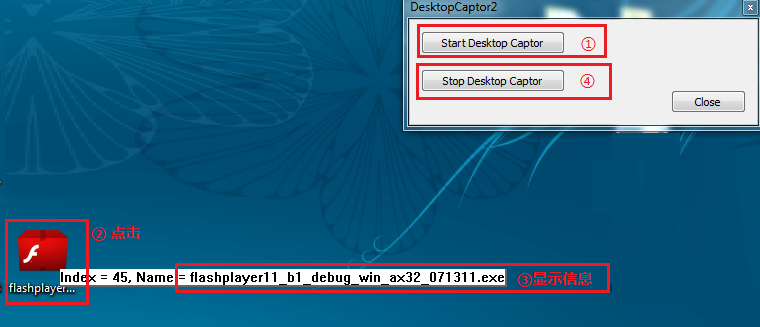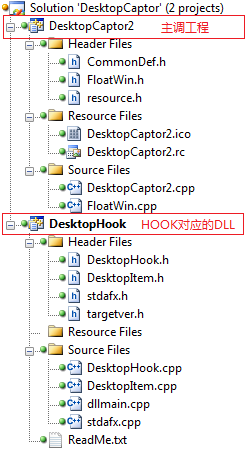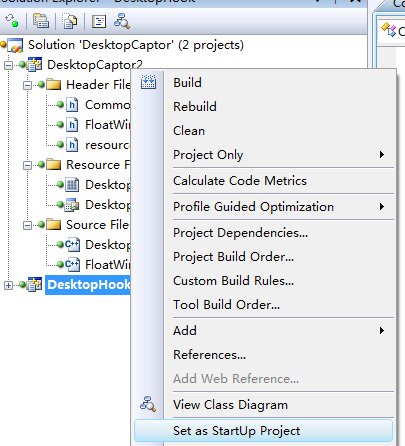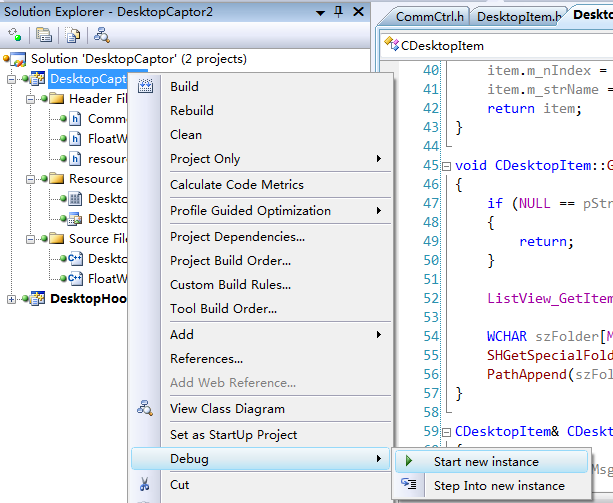| 需求:截获桌面窗口鼠标单击事件,解析所选中的桌面
Item,并将解析后的 item 信息发送给主调程序,并将信息显示在一个窗口上面。如下图:

思路:
1. 确定HOOK的类型。很明显,这一个进程外的HOOK,我们的应用程序DesktopCaptor2.exe
需要捕获 Explorer.exe 这个进程的桌面窗口所在的线程的消息。因此,需要将HOOK过程放在一个独立的DLL
中去,然后使用 SetWindowsHookEx 将HOOK过程安装到HOOK链中去。
2. 如何解析点击的桌面 Item 信息?这个其实也比较好做,由于桌面窗口本身是一个
listview 控件(不解释),因此,我们可以通过 listview 拿到桌面窗口的简单信息。
3. 如何将解析后的桌面 Item 信息发送给主调程序,让它弹出一个窗口,并显示桌面
Item 信息?我们这里采用WM_COPYDATA 将从桌面进程获取到信息发送到我们的应用程序。
工程目录如下:

在主调程序(DesktopCaptor2.exe)是一个简单Win32
Dialog的程序。在这个程序中,我们干了两件事情:
1. 调用 DekstopHook 工程中的 DesktopHook.h
中的两个导出函数,通过这两个函数,对 HOOK 过程安装和卸载。
2. 接收来自于Explorer.exe 进程发送的 WM_COPYDATA
消息,还原桌面 Item 数据,并将在点击桌面 Item 的位置弹出一个窗口出来,显示 Item 信息。至于这个窗口如何制作,我就不再描述了。
以下为部分代码:
#include "CommonDef.h"
#include "DesktopHook.h"
#include "FloatWin.h"
const UINT WM_DESKTOP_CLICKED_ITEM = RegisterWindowMessage(L"WM_DESKTOP_CLICKED_ITEM");
BOOL g_isCaptured = FALSE;
CFloatWin* g_floatWin = NULL;
INT_PTR WINAPI DlgProc(HWND hwnd, UINT uMsg, WPARAM wParam, LPARAM lParam) ;
int WINAPI _tWinMain(HINSTANCE hinstExe, HINSTANCE, PTSTR pszCmdLine, int)
{
HWND hwnd = FindWindow(TEXT("#32770"), TEXT("DesktopCaptor2"));
if (IsWindow(hwnd))
{
// An instance is already running, show a messagebox
MessageBox(GetForegroundWindow(), L"An instance is already running", L"Error", MB_ICONERROR);
}
else
{
DialogBox(hinstExe, MAKEINTRESOURCE(IDD_DESKTOP_CAPTOR), NULL, DlgProc);
}
return(0);
}
INT_PTR CALLBACK DlgProc(HWND hDlg, UINT message, WPARAM wParam, LPARAM lParam)
{
UNREFERENCED_PARAMETER(lParam);
switch (message)
{
case WM_INITDIALOG:
{
// Set icon for the application
SendMessage(hDlg, WM_SETICON, ICON_BIG, (LPARAM)
LoadIcon((HINSTANCE) GetWindowLongPtr(hDlg, GWLP_HINSTANCE),
MAKEINTRESOURCE(IDI_DESKTOPCAPTOR2)));
// Set dialog's position
int nScreenWidth = ::GetSystemMetrics(SM_CXSCREEN);
int nScreenHeight = ::GetSystemMetrics(SM_CYSCREEN);
RECT rect = { 0 };
GetWindowRect(hDlg, &rect);
SetWindowPos(
hDlg,
HWND_TOP,
nScreenWidth - (rect.right - rect.left),
0,
0, 0,
SWP_NOSIZE);
g_floatWin = CFloatWin::getInstance();
}
return (INT_PTR)TRUE;
case WM_COMMAND:
{
UINT wmId = LOWORD(wParam);
UINT wmEvent = HIWORD(wParam);
switch (wmId)
{
case IDOK:
case IDCANCEL:
EndDialog(hDlg, LOWORD(wParam));
return (INT_PTR)TRUE;
case IDC_START_CAPTOR:
if (FALSE == g_isCaptured)
{
<strong> </strong>g_isCaptured = CreateDesktopEventCaptor(hDlg);
}
break;
case IDC_STOP_CAPTOR:
if (TRUE == g_isCaptured)
{
CloseDesktopEventCaptor();
g_isCaptured = FALSE;
}
break;
default:
return DefWindowProc(hDlg, message, wParam, lParam);
}
}
break;
case WM_COPYDATA:
{
COPYDATASTRUCT* pCopyData = (COPYDATASTRUCT*)lParam;
if (pCopyData->dwData == WM_DESKTOP_CLICKED_ITEM)
{
DesktopItemData itemData(*(DesktopItemData*)pCopyData->lpData);
g_floatWin->ShowWindow(TRUE, &itemData);
}
}
break;
}
return (INT_PTR)FALSE;
} |
我们重点说明一下DekstopHookDLL中的内容。
DesktopHook.h 中定义的是一些导出接口,代码如下:
#ifndef _DESKTOPHOOK_H_
#define _DESKTOPHOOK_H_
//#ifdef __cplusplus
//extern "C" {
//#endif
#ifdef DESKTOPHOOK_EXPORTS
#define DESKTOPHOOK_API __declspec(dllexport)
#else
#define DESKTOPHOOK_API __declspec(dllimport)
#endif
typedef struct DESKTOPHOOK_API _DesktopItemData
{
POINT point;
WCHAR szName[MAX_PATH]; // The desktop item's name.
int nIndex; // The desktop item's index on desktop.
_DesktopItemData()
{
ZeroMemory(szName, MAX_PATH);
point.x = point.y = 0;
nIndex = -1;
}
_DesktopItemData(POINT pt, WCHAR* pszName, int nIx)
{
if (NULL != pszName)
{
point.x = pt.x;
point.y = pt.y;
ZeroMemory(szName, MAX_PATH);
_tcscpy_s(szName, MAX_PATH, pszName);
nIndex = nIx;
}
}
_DesktopItemData(const _DesktopItemData& itemDataRef)
{
point.x = itemDataRef.point.x;
point.y = itemDataRef.point.y;
ZeroMemory(szName, MAX_PATH);
_tcscpy_s(szName, MAX_PATH, itemDataRef.szName);
nIndex = itemDataRef.nIndex;
}
_DesktopItemData& operator = (const _DesktopItemData& itemDataRef)
{
point.x = itemDataRef.point.x;
point.y = itemDataRef.point.y;
ZeroMemory(szName, MAX_PATH);
_tcscpy_s(szName, MAX_PATH, itemDataRef.szName);
nIndex = itemDataRef.nIndex;
return *this;
}
} DesktopItemData, *LPDesktopItemData;
EXTERN_C DESKTOPHOOK_API BOOL CreateDesktopEventCaptor(HWND hNotifierhWnd);
EXTERN_C DESKTOPHOOK_API void CloseDesktopEventCaptor();
//#ifdef __cplusplus
//}
//#endif
#endif // _DESKTOPHOOK_H_ |
其中:
1. DesktopItemData 结构体是用来存放解析桌面 Item
的数据。
2. CreateDesktopEventCaptor 函数是用来安装
HOOK;
3. CloseDesktopEventCaptor 函数是用来卸载 HOOK;
以下是 DesktopHook.cpp 中的实现代码:
// DesktopHook.cpp : Defines the exported functions for the DLL application.
//
#include "stdafx.h"
#include "DesktopHook.h"
#include "DesktopItem.h"
#pragma data_seg("SHARED_DATA")
HWND g_hNotifierWnd = NULL;
HHOOK g_hPostMsgHook = NULL;
WCHAR g_szBuf[MAX_PATH] = {0};
#pragma data_seg()
#pragma comment(linker, "/SECTION:SHARED_DATA,RWS")
// Global data
const UINT WM_DESKTOP_CLICKED_ITEM = RegisterWindowMessage(L"WM_DESKTOP_CLICKED_ITEM");
HMODULE g_hModule;
HWND g_hDesktopWnd = NULL;
// The low-order word specifies the x-coordinate of the cursor.
// The high-order word specifies the y-coordinate of the cursor.
BOOL g_bDoubleClick = FALSE;
UINT_PTR g_timerID = 0;
POINT g_clickPt;
CDesktopItem g_singleClickDesktopItem = CDesktopItem::Empty;
DesktopItemData g_desktopItemData;
// Declaration of methods.
static HWND FindShellWindow();
static LRESULT CALLBACK GetMsgProc(int code,WPARAM wParam,LPARAM lParam);
static VOID CALLBACK TimerProc(HWND hwnd, UINT uMsg, UINT_PTR idEvent, DWORD dwTime);
EXTERN_C DESKTOPHOOK_API BOOL CreateDesktopEventCaptor(HWND hNotifierhWnd)
{
g_hDesktopWnd = FindShellWindow();
if (NULL == g_hDesktopWnd)
{
OutputDebugString(L"Can not find desktop window handle");
return FALSE;
}
g_hNotifierWnd = hNotifierhWnd;
// Get desktop handle's thread id.
DWORD targetThreadid = ::GetWindowThreadProcessId(g_hDesktopWnd, NULL);
// Hook post message.
g_hPostMsgHook = ::SetWindowsHookEx(WH_GETMESSAGE, &GetMsgProc, g_hModule, targetThreadid);
if (g_hPostMsgHook != NULL)
{
return TRUE;
}
return FALSE;
}
EXTERN_C DESKTOPHOOK_API void CloseDesktopEventCaptor()
{
if (g_hPostMsgHook != NULL)
{
::UnhookWindowsHookEx(g_hPostMsgHook);
}
}
HWND FindShellWindow()
{
// Sometimes, we can't find the desktop window when we use this function, but we must
// find it's handle, so we do a loop to find it, but at most we find for 10 times.
UINT uFindCount = 0;
HWND hSysListView32Wnd = NULL;
while (NULL == hSysListView32Wnd && uFindCount < 10)
{
HWND hParentWnd = ::GetShellWindow();
HWND hSHELLDLL_DefViewWnd = ::FindWindowEx(hParentWnd, NULL, L"SHELLDLL_DefView", NULL);
hSysListView32Wnd = ::FindWindowEx(hSHELLDLL_DefViewWnd, NULL, L"SysListView32", L"FolderView");
if (NULL == hSysListView32Wnd)
{
hParentWnd = ::FindWindowEx(NULL, NULL, L"WorkerW", L"");
while((!hSHELLDLL_DefViewWnd) && hParentWnd)
{
hSHELLDLL_DefViewWnd = ::FindWindowEx(hParentWnd, NULL, L"SHELLDLL_DefView", NULL);
hParentWnd = FindWindowEx(NULL, hParentWnd, L"WorkerW", L"");
}
hSysListView32Wnd = ::FindWindowEx(hSHELLDLL_DefViewWnd, 0, L"SysListView32", L"FolderView");
}
if (NULL == hSysListView32Wnd)
{
Sleep(1000);
uFindCount++;
}
else
{
break;
}
}
return hSysListView32Wnd;
}
// The message which is "Post" type can be hook in this hook procedure.
LRESULT CALLBACK GetMsgProc(int code, WPARAM wParam, LPARAM lParam)
{
MSG* pMsg = (MSG*)lParam;
if( NULL != pMsg && pMsg->hwnd != NULL )
{
switch(pMsg->message)
{
case WM_MOUSEMOVE:
{
//OutputDebugStringW(L"Mouse Move");
}
break;
case WM_LBUTTONUP:
{
//OutputDebugStringW(L"WM_LBUTTONUP");
if (g_bDoubleClick)
{
OutputDebugString(L"g_bDoubleClick == TRUE");
g_singleClickDesktopItem = CDesktopItem::Empty;
g_bDoubleClick = FALSE;
::KillTimer(NULL, g_timerID);
}
else
{
OutputDebugString(L"g_bDoubleClick == FALSE");
::KillTimer(NULL, g_timerID);
g_clickPt.x = pMsg->pt.x;
g_clickPt.y = pMsg->pt.y;
g_singleClickDesktopItem = pMsg;
g_timerID = ::SetTimer(NULL, 1, ::GetDoubleClickTime(), TimerProc);
}
}
break;
case WM_LBUTTONDBLCLK:
g_bDoubleClick = TRUE;
break;
}
}
return ::CallNextHookEx(g_hPostMsgHook, code, wParam, lParam);
}
VOID CALLBACK TimerProc(HWND hwnd, UINT uMsg, UINT_PTR idEvent, DWORD dwTime)
{
UNREFERENCED_PARAMETER(hwnd);
UNREFERENCED_PARAMETER(uMsg);
UNREFERENCED_PARAMETER(idEvent);
UNREFERENCED_PARAMETER(dwTime);
if (g_timerID == idEvent &&
g_bDoubleClick == FALSE &&
g_singleClickDesktopItem != CDesktopItem::Empty)
{
OutputDebugString(L"SendMessageTimeout Process begin");
wstring strName = g_singleClickDesktopItem.GetItemName();
//_tcscpy_s(g_szBuf, MAX_PATH, strName.c_str());
//::PostMessage(g_hNotifierWnd, WM_DESKTOP_CLICKED_ITEM, NULL, (LPARAM)g_szBuf);
ZeroMemory(&g_desktopItemData, sizeof(DesktopItemData));
g_desktopItemData.point.x = g_clickPt.x;
g_desktopItemData.point.y = g_clickPt.y;
_tcscpy_s(g_desktopItemData.szName, MAX_PATH, strName.c_str());
g_desktopItemData.nIndex = g_singleClickDesktopItem.GetItemIndex();
COPYDATASTRUCT copyData;
copyData.dwData = (UINT_PTR)WM_DESKTOP_CLICKED_ITEM;
copyData.cbData = sizeof(DesktopItemData);
copyData.lpData = &g_desktopItemData;
DWORD_PTR rt = -1;
SetActiveWindow(g_hNotifierWnd);
SetForegroundWindow(g_hNotifierWnd);
//SendMessageTimeout(g_hNotifierWnd, WM_COPYDATA,
(WPARAM)g_hDesktopWnd, (LPARAM)?Data, SMTO_NORMAL, 1000, &rt);
SendMessage(g_hNotifierWnd, WM_COPYDATA, (WPARAM)g_hDesktopWnd, (LPARAM)?Data);
OutputDebugString(L"SendMessageTimeout Process end");
}
::KillTimer(NULL, g_timerID);
} |
说明:在该实现中,CreateDesktopEventCaptor 函数与
CloseDesktopEventCaptor 函数被 DesktopCaptor2.exe 进程调用,此时,DesktopHook.dll
会被加载到 DesktopCaptor2.exe 所在进程,当使用 CreateDesktopEventCaptor
函数后,HOOK 过程函数 GetMsgProc 会被安装到 Explorer.exe 进程中去,此时,DesktopHook.dll
会被加载到 Explorer.exe 中去。当用鼠标单击桌面 Item 时,消息将被传递到 GetMsgProc
中去,然后,在这个函数中发送一个 WM_COPYDATA 消息给DesktopCaptor2 的窗口,实际上,这相当于是
Explorer.exe 进程发送的 WM_COPYDATA 消息到 DesktopCaptor2.exe
进程 。需要注意一点的是,在 GetMsgProc 中发送消息的时候,g_hNotifierWnd 必须要设置成为共享数据,因为它是DesktopCaptor2.exe
进程在调用 DesktopHook.dll 的 CreateDesktopEventCaptor 函数的时候被设置的,要想在Explorer.exe进程中继续有效,需要将之设置为
DLL共享数据。
另外,这里还有另外两个问题:
1、如何找到 Desktop 窗口句柄? 通过Spy++,我们得到:

其中,蓝色部分就是我们的桌面窗口句柄。我们的 FindShellWindow
函数就是为了干这个事情,但是有时候,这个函数会失败,因此,我们最多循环10次去查找桌面窗口句柄。
2、WH_GETMESSAGE 类型的消息 HOOK 只能钩住使用 PostMessage
方式发送的消息,这点很重要,否则,如果是以SendMessage发送的方式,则需要使用 WH_CALLWNDPROC
或者 WH_CALLWNDPROCRET 的 HOOK 方式。
3、如何解析点击桌面的 Item 信息?
实际上,由于桌面窗口本身是一个 ListView 控件,通过ListView
的控件的API,我们便能够拿到相关的信息(当然这里只是一个简单的信息,深层次的信息还需要深掘)。
首先,通过下面的函数,能够拿到选中的 Item 的 ID,其中 hwnd
就是桌面窗口句柄。
UINT ListView_GetSelectedCount(
HWND hwnd
); |
其次,通过下面的函数,传入选中的 Item 的 ID,我们就能拿到 Item 对应的文本。
void ListView_GetItemText(
HWND hwnd,
int iItem,
int iSubItem,
LPTSTR pszText,
int cchTextMax
); |
在这里,我使用了一个 CDesktopItem 类来专门干这个事情。
至此,简单的代码讲解就结束了。
下面说一下如何调试。
因为本例子是进程外的HOOK,因此调试起来有很多不方便的地方。调试的难处在于如何调试HOOK过程函数。先说一个简单的例子,可能大家经常会遇到这种情况:假如一个Solution下有ProjectA和
Project B,它们都是exe,但涉及到相互发消息,有人就会打开2个Visual Studio,同时进行调试,这样的确可以做到,但总感觉不太方便。实际上,在同一个Visual
Studio中,是可以同时调试多个程序的。对于刚刚这种情况,只需要在每个Project A 和 ProjectB
上面分别右击->Debug->Start new instance 即可。
然而,对于本例,这样做是不行的,因为 DesktopHook 是一个DLL工程,本身是无法进行独立调试的。因此,要想同时调试
DesktopCaptor2 工程和 DesktopHook 工程,需要按如下操作:
1、将DesktopHook工程设置为默认启动的工程。如图:

2、将 DesktopCaptor2 工程通过 右击->Debug->Start
new instance 启动起来,点击 Start Desktop Captor 按钮启动HOOK,将DesktopHook
.dll 注入到进程Explorer.exe中去。

3、将 DesktopHook 工程到附加(Attach)到Explorer.exe进程中去。如图:
点击 Tools->Attachto Process...

然后找到Explorer.exe,点击Attach按钮即可。
通过上面的这种方式,我们就能够很简单的在一个工程中,调试两个不同的进程的程序。这时,我们将断点打在DesktopHook
工程的函数 GetMsgProc中,并在DesktopCaptor2 工程 WM_COPYDATA 内部打上断点,发现点击桌面图标时,断点会走到GetMsgProc内部,当发送完消息后,就能走到DesktopCaptor2
工程 WM_COPYDATA 内部。。
另外,你调试的时候,要注意一下当前用户的权限以及Visual Studio的权限。如果当前用户是管理员组用户,而你的VisualStudio是以管理员启动进来的,那么DesktopCaptor2.exe将也是管理员权限,但此时,Explorer.exe却是普通权限,此时,在GetMsgProc内部发送WM_COPYDATA是会出现问题的,因为不能向高权限进程发送消息。
|